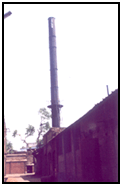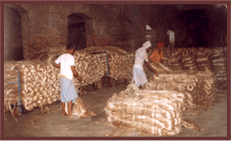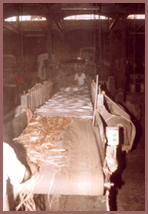|
|
|
Technology
|
|
|
|
Jute Manufacturing in Jute Mills
Raw jute in the form of bales are
processed in jute mills to produce hessian, sacking, jute yarn, bags, and other
useful products. Raw jute bales from jute fields or suppliers, carried by
trucks are unloaded are stacked in the jute mills gowdown. The production
of jute goods from raw jute processing involves the following steps:
|

|
 |
Selection :
In the selection process, raw jute bales are opened to find out any defect and
to remove the defective portion from the mora by experienced workers. Raw
jute bales are of two types i.e. 150 kg weight and 180 kg weight with or without
top portion cutting. The bales are assorted according to end use like
Hessiean weft, Sacking wrap, Sacking weft etc. After selection, jute bales
are carried to softning section by workers called Gariwala and Bajawala.
|
|
|
|
|
|

|
Jute Processing Chart
|
|
|

|
Selection,
Softening & Piling, Carding
|
|
|

|
Drawing
& Doubling, Spinning, winding, Beaming/Dressing
|
|
|

|
Weaving,
Damping & Calendering, Lapping, Cutting
etc.
|
|
|

|
UNDP and Govt. of
India - National Jute
Development Program
|
|
|

|
Productivity
Improvement in Jute Industry - Report by I. I. T Kharagpur, 2000
|
|
|

|
Rice
Bran Oil (RBO) Technology - Food Grade Bags
|
|
|

|
Jute Composites
|

|
Advance Jute
Testing Equipment
|
|
Softning :
In softning process jute morahs
are made soft and pileable. Two methods are used for softning; use of
softning machine and use of jute good spreader. Generally an emulsion
plant with jute softner machine is used to lubricate and soften the bark and
gummy raw jute. The emulsion plant consists of gear pump, motor, vat, jet
sprayer, nozzles, emulsion tank and the jacket. In this softning process
jute becomes soft and pileable and suitable for carding.
|

|
|
Piling and pile Breaking
:
The main function of pile breaker
is to break the pile and serve it to the carding machines. The softner
machine out put material carried by pilemen through a bile to the pile place for
pilling. During piling a superficial moisture penetrates inside fibre and
"Thermo fillic" action take place which softner the hard portion of
the root. After piling for nearly 24 hours the pile breakers carry the
material to the carding machine.
Generally root cutting is done after piling near the hand feed breaker carding
machine. The root weight varies from 5 to 7% of the total weight of jute.
|
|
Carding :
Carding is a combining operation
where jute reeds are splitted and extraneous matters are removed. Jute
fibres are formed into ribbon called "sliver". There are three
different carding sections: (i) breaker carding (ii) inner carding (iii) and
finisher carding
|
|
Breaker Carding
:
In different jute mills the carding operations has been carried out in two ways:
a. Hand feed breaker carding
b. Rool feed breaker carding
The material after piling more
than 24 hours is used in hand feed breaker where the material after piling for
12 hours used in the rool feed carding.
In the Breaker carding machine soften jute after piling is feed by hand in
suitable weight. The machine by action with different rollers turns out
raw jute in the form of jute sliver for finisher carding. In this process
root cutting is necessary before feeding the material to the hand feed breaker
carding machine.
|
|
Finisher Carding
:
Finisher carding machine make the sliver more uniform and regular in length and
weight obtained from the Breaker carding machine. Finisher carding machine
is identical to the Breaker carding machine, having more pair of rollers,
staves, pinning arrangement and speed. Nearly 4 to 12 slivers obtained
from Breaker carding machine is fed on this machine. The material thus
obtained is send to drawing section.
|
|
|

|
Research in Jute
Related Fields
|
|
|
|
|
|
|
|
|
|
|
|
|
|
|
|
|
|
|
|
|
|
|
|
|
|
|
|
|
|
|
|
|
|
|
|
|
|
|
|
|
|
|
|

